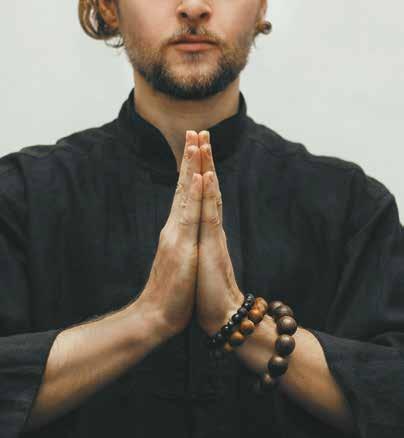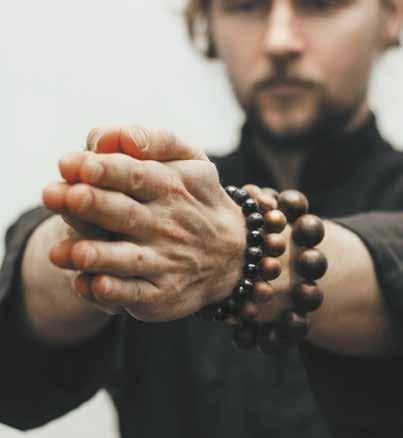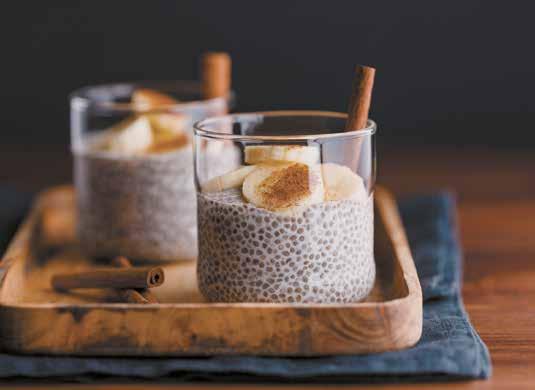
4 minute read
TAI CHI AND QIGONG
TAI CHI AND QIGONG Life Force in Motion
by Marlaina Donato
Advertisement
The flowing movement of tai chi mirrors the serenity of water, but still waters run deep. This ancient practice of gentle meditative movement is an offshoot of Chinese martial arts that offers a spectrum of surprising benefits, including healthier soft tissues and bones, as well as improved sleeping.
According to Harvard Health Publishing, when practiced consistently, tai chi supports both upper and lower body strength with effects that are akin to resistance training and brisk walking. Tai chi helps to fine-tune neurons of the inner ear and encourages muscle and ligament flexibility, resulting in better balance and fewer falls. The practice is highly adaptable and anyone can benefit, even those that are wheelchair-bound or recovering from surgery.
“It appears effortless, with slow and smooth movements, but there is immense power underneath the tranquility,” says Paul Lam, family physician and director of the Tai Chi for Health Institute, in Sydney, Australia. “Tai chi has been shown by over 500 medical studies to benefit almost all aspects of health, including mobility, immunity and heart and lung function.” Lam also
highlights other related benefits, including lower blood pressure, less arthritis pain and stress relief.
Research published last year in the journal Evidence-Based Complementary and Alternative Medicine shows that 12 weeks of tai chi practice initiated beneficial changes in the immune system with subsequent improvement of lung function in children ages 6 to 12 with asthma.

A River of Energy
While tai chi is a modified martial art with a focus on form, its close relative, qigong, is a mind-body wellness system that uses breath, simple movement and stillness. Both cultivate qi, or life force, that is believed to permeate all natural existence. The concept of qi, yet to be understood scientifically, is the basis of Traditional Chinese Medicine and the focus of many studies in China and elsewhere.
“It is believed that qi flows throughout and around the body. If we are healthy, the qi will be moving smoothly and abundantly. If we are not healthy, the qi may be stagnant, excessive or defi
cient,” says qigong instructor and acupuncturist Jeffrey Chand, in British Columbia, Canada.
Robert Chuckrow, a retired physics professor in Ossining, New York, and the author of Tai Chi Dynamics and The Tai Chi Book, explains, “When muscles are tensed, qi is inhibited. Instead, when muscles are relaxed and the body is open and moves naturally, qi is enhanced. Such cultivation of qi is the main component of qigong. Tai chi actually includes qigong.” Chuckrow currently has two students that are 100 years old and notes that seniors greatly appreciate and benefit from these arts once they experience the connection between mind and body.
Lee Holden, a qigong master teacher at the Holden QiGong Center,in Santa Cruz, California, emphasizes the consequence of being in perpetual “fight-or-flight” mode from everyday, nonthreatening life stresses. “The waves crashing to the shore, the river flowing down the mountain, demonstrate nature’s boundless energy. We, as human beings, have cut ourselves off from that source of energy. Through qigong practice, we plug back into that natural energy reserve and circulate it through our minds and bodies. Stress, like a kink in the hose, causes a stagnation of qi. Relaxation, like unwinding the kink, gets the qi to flow.”
Nourishing the Nervous System
Tai chi and qigong lower the stress hormone cortisol, improve brain function and have been shown to decrease symptoms of anxiety and depression. Both approaches are part of many addiction recovery programs to help nourish mind-body connections for better managing stress.
“In my view, both qigong and tai chi are wonderful exercises for the nervous system, which during practice, undergoes intense moment-to-moment receiving, processing and sending of neural electrical information. This electricity stimulates cells to absorb oxygen and nutrients and expel waste products, and it beneficially helps arrange material within cells,” says Chuckrow.
In essence, it’s all about encouraging calm, something we all need. Chand summarizes its benefits superbly. “It empowers individuals to help themselves. The more stress management tools we have to help ourselves, the better our overall health and quality of life is.”
Marlaina Donato is a body-mind-spirit author and visionary composer. Connect at AutumnEmbersMusic.com.
Helpful Links Communi Qi is an online video library of qigong practices offered temporarily on a complimentary basis “to help people thrive through this challenging time,” says Jeffrey Chand. Tinyurl.com/PositiviQiSeries
How Does Practicing T’ai Chi Reduce Falls? by Robert Chuckrow Tinyurl.com/TaiChiReducesFalls
in Milwaukee
A positive path for spiritual living.


LGBT Friendly.
VISION Centered in God, we co-create a world that works for all.
1717 North 73rd Street Wauwatosa, WI 53213 414-475-0105 ucim@wi.rr.com unitycenterinmilwaukee.com Sunday service 10:00am
Our Teachings Unity teaches that each person is a unique expression of God created with sacred worth. Living from that awareness transforms our lives and the world.
Is PAIN or TIGHTNESS limiting your activities? Muscle Activation Techniques (MAT) restores flexibility, strength & balance so you can enjoy your life again! Complimentary Consultation...Call today! 414-405-3956 | 1212bodyworks.com
1 2 1 2 Bodyworks
Emily Yenor Physical Therapist & MAT Specialist






